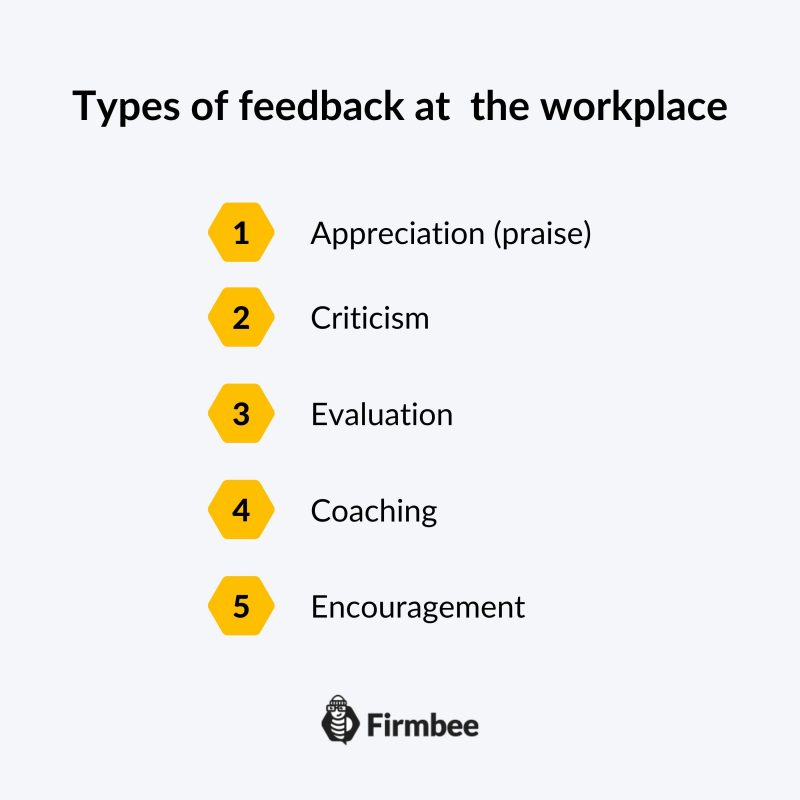Formal and informal feedback – those are two out of several types of feedback you may expect in the workplace. Effective management of human resources aims to organize all activities of employees to help with achieving of all main goals of company. All the channels of communication in the workplace have to be operational otherwise achieving goals may be hindered. Feedback is the basis of functional communication inside and outside of the organization. Great interpersonal relations, commitment of the employees and mutual understanding of all parties depend on good, smooth communication.
Formal and informal feedback – table of content:
- What is feedback?
- Effective feedback in the workplace
- Formal and informal feedback at the workplace
- Summary
What is feedback?
Feedback, as it is understood in the workplace, is the entirety of messages between the employee and the other parts of the organization. In such form, feedback is a great tool for learning, development and implementing changes that can be based on the experience gained by the employee or by his coworkers. The main aim of feedback, from the perspective of human resources level, is creation of the environment that allows modifications of future activities and decisions as the knowledge increases.
There are many different methods of feedback, and it can be both: direct, indirect, confidential, rudimentary, or detailed. Employees may expect negative and positive feedback. In both cases, feedback has to be constructive, since it should help to develop good habits and correct mistakes. Negative feedback given in a nasty way may become a starting point for a conflict, it definitely influences the receiver in a destructive way. Feedback influences effectiveness of work, personal growth of the employee and helps to motivate individuals to gain new competencies and skills. It enhances communication, team work and commitment.
Effective feedback in the workplace
The way of how feedback is given determines its effectiveness. While giving feedback the manager should focus on improvement of work results. Excessive criticizing, subjective opinions should be avoided, while discussing work performance. All managers agree, that giving negative feedback is the most difficult – it is much easier to praise than chastise.
Still, corrective, negative feedback is necessary to keep the effectiveness of individuals and teams on the required level. From the practical point of view it is much better to give feedback that is structured, organized and well-thought before the process. For great feedback it is better to held a special meeting with an employee, where all the aspect of work can be discussed at once.
Feedback should include such elements:
- analysis of the current situation, problem identification, reasons for the problem, pointing out of specific, concrete behavior
- the aim of the feedback should be given, as well as the expected results
- constructive feedback should be descriptive, not judgmental
- tone of voice and way of talking should be adjusted to the individuality of the employee. The wording should be appropriate to the situation, all the information should be given with respect for the receiver
- the employee has a right to reply and react to the feedback given, both manager and the employee should try to find the best solution to the problem, they should aim for mutual understanding
- the realization of corrective plan should be checked and all improvements in behavior of the employee should be praised.
Formal and informal feedback at the workplace
Feedback can be classified accordingly to different criteria and it can be either:
- judgmental and corrective (form of feedback)
- comparative or directing (type of information given)
- ex-post and ex-ante (time of giving)
- formal and informal (source of feedback)

The most popular types of feedback are formal and informal. Formal feedback occurs in the form of formalized reports and analysis, that describe achieved results based on predefined goals.
Such feedback include such elements as detailed criteria, descriptions of competencies, and sets of standards. Solutions for improvement are enlisted in case of deviation from the plan or mistakes. The form of formal feedback can be either judgmental or corrective. Formal feedback is usually planned and predetermined and fixed arbitrarily.
Informal feedback are seen more like helpful information or negative judgement given by the manager to the employee to improve his performance and effectiveness. Sometimes informal feedback is related to the situations that are ad hoc in nature and everyday social interactions. Such feedback is more difficult to characterize, but what is the most important here is the knowledge an individual gains from the organizational structure. Informal feedback may be highly subjective.
Formal feedback is seen as more objective, concrete and easy to analyze, while informal feedback is perceived as more effective and influential.

Summary
Giving feedback is not an easy task. Commitment and openness to potential gains is required from both the manager and his employee. Both parties have to be convinced about the value of their communication and should not show bias or negativity. It is beneficial to give feedback without haste and with greater care for the main information. Feedback plays the key role in interpersonal communication and may help to correct behavioral mistakes, as well as remove doubts, prevent crisis situation and contribute to the professional growth of employees.
Check out 5 most popular types of crowdfunding
If you like our content, join our busy bees community on Facebook, Twitter, LinkedIn, Instagram, YouTube.
Author: Nicole Mankin
HR manager with an excellent ability to build a positive atmosphere and create a valuable environment for employees. She loves to see the potential of talented people and mobilize them to develop.


















